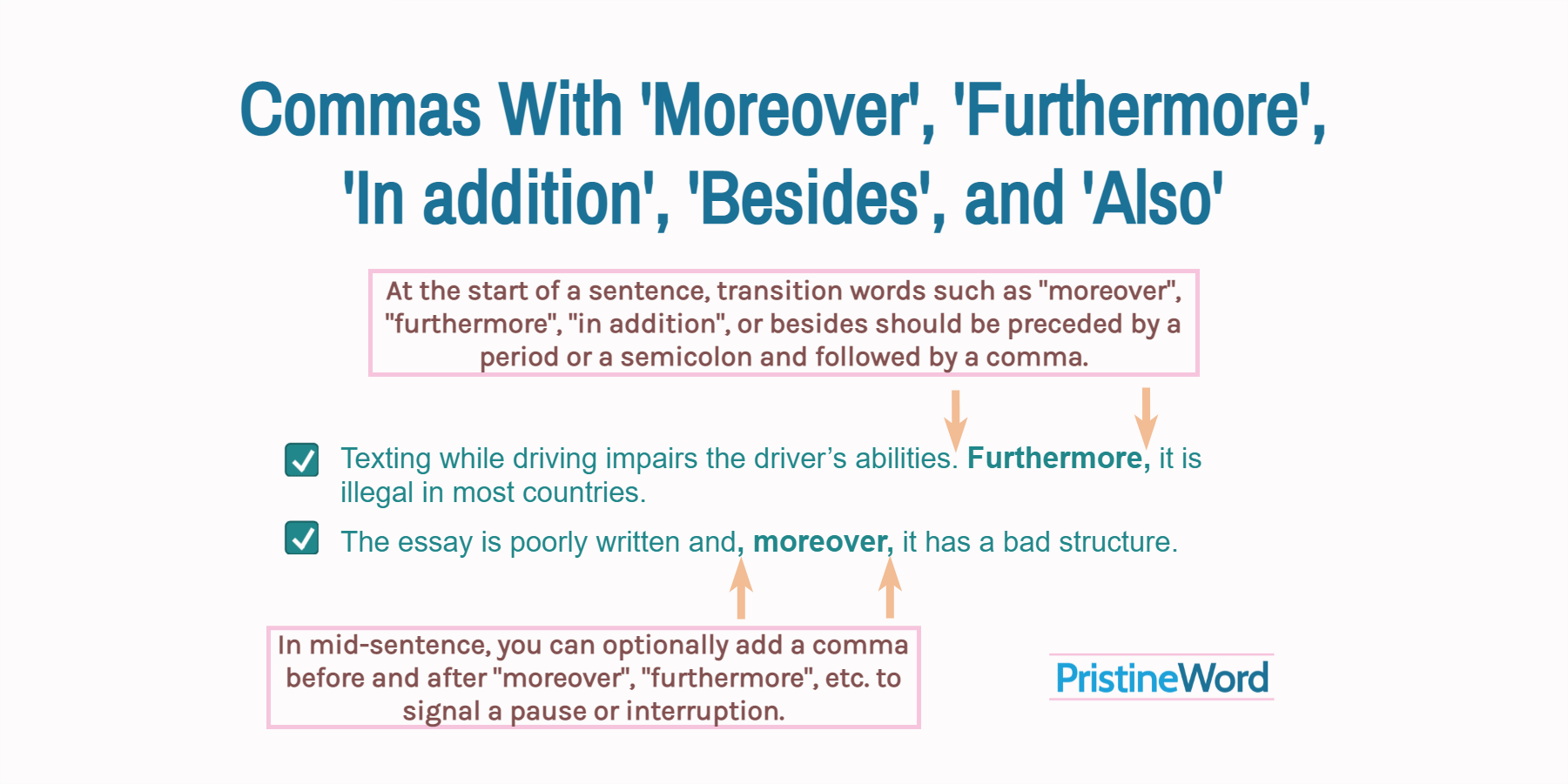At the beginning of a sentence, transition words such as "moreover", "furthermore", "in addition", or "besides" should be preceded by a period or a semicolon and followed by a comma.
At the beginning of a sentence, transition words such as "moreover", "furthermore", "in addition", or "besides" should be preceded by a period or a semicolon and followed by a comma.
Texting while driving impairs the driver’s abilities. Furthermore, it is illegal in most countries.
Texting while driving impairs the driver’s abilities. Furthermore it is illegal in most countries.
In mid-sentence, you can optionally add a comma before and after "moreover", "furthermore", etc. to signal a pause or interruption.
The essay is poorly written and, moreover, it has a bad structure.
Contents
1 Moreover and Furthermore
"Moreover" and "furthermore" are mostly used in writing or formal conversations to mean "in addition to what has been said before".
1.1 Punctuation
At the start of a sentence, add a comma after "moreover" or "furthermore" to signal that the adverb modifies not just the word that follows, but the complete sentence or clause that follows.
Indonesia is a nice place to visit; it has pristine and idyllic beaches. Furthermore, you should explore its tropical forests and wildlife.
You can narrow the gap between two sentences by using a semicolon instead of a comma. Be aware that we do not capitalize "furthermore" or "moreover" in this case.
You should take the job because it's well paid; furthermore, it aligns with your long-term career goals.
In the middle of a sentence, we usually place "moreover" or "furthermore" between commas to introduce additional facts, ideas, arguments, etc.
Smoking is bad for your health; doctors say it; researchers say it. It has, moreover, been proved by statistics.
1.2 Differences between "Furthermore" and "Moreover"
The conjunctive adverbs "furthermore" and "moreover" are closely related, but they do not mean exactly the same.
Use "furthermore" to add one or more reasons to those previously mentioned.
Mediterranean food is delicious. Furthermore, it may help you lose weight and prevent heart disease.
But use "moreover" to support an argument in different ways.
I don't like pasta; my wife doesn't enjoy eating pasta. Moreover, our son hates it.
Consequently, we use:
- "Furthermore" when adding a list of different arguments.
- "Moreover" to express the same argument from different perspectives.
2 'Also', 'In addition', 'Additionally', and 'In addition to'
We use "also", "in addition", or "additionally" to give additional information after something else.
In terms of formality:
- "Also" is informal
- "Additionally" is less formal
- "In addition" is considered formal
2.1 Punctuation
Typically, "in addition" or "additionally" appear at the start of a sentence to introduce additional points. As mentioned above, use a comma after these words in front position.
Playing chess helps develop perspective and improves memory. In addition, it deepens focus and elevates creativity.
We can also use the expression "in addition to" to introduce a phrase. In this case, add a comma after the phrase that follows.
This job is great. In addition to a good salary, you will have extra benefits.
It is acceptable to start a sentence with "also" in written English. Some English teachers, however, recommend avoiding it because an essay may seem poor structured and difficult to comprehend when using "also" in front. Moreover, readers may spend some time trying to figure out the right connection between two ideas. So, be careful!
Patricia has just bought a big house and a new car. Also, she is thinking about buying a boat.
When using these conjunctive adverbs in mid-sentence, enclose them in commas to signal a strong interruption. Skip the commas if the interruption is weak.
The government, additionally, has implemented a new project to reduce the number of unintended pregnancies.
The device may in addition be used to indicate failures or defects in the system.
3 'Besides' and 'On top of that'
We typically use "besides" or "on top of that" to introduce a final point or strengthen a previous argument. These transition words are quite informal and not often used in writing.
3.1 Punctuation
Place a comma after "besides" or "on top of that" at the start of a sentence.
I don't feel like going out tonight. Besides, I have to study for a math test.
Mary overslept and is going to be late for work. On top of that, she cannot find the car keys.
As mentioned above, we can separate these expressions with commas to stress a pause in the middle of a sentence.
3.2 How to use 'Besides' and 'On top of that'
"Besides" can be used to make an informal point or strengthen the previous one by adding a final argument. In other words, we typically use "besides" to:
- add the cherry on top of the cake after listing a number of satisfactory reasons, or
- suggest that even if the entire previous argument were wrong, you should accept the conclusion for this other reason.
Would you like to eat a lasagna? No, thanks, it's not my favorite meal; besides, I'm not even hungry.
"On top of that" is an informal way of saying "additionally" or "furthermore". "On top of that" is seldom used in written English, but it is quite common in spoken English.
The situation is getting worse and, on top of that, the participants aren't really helping.

